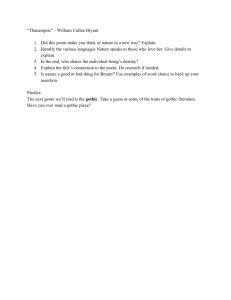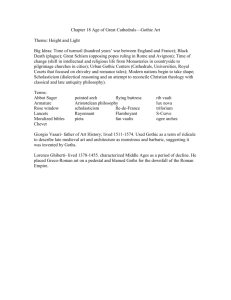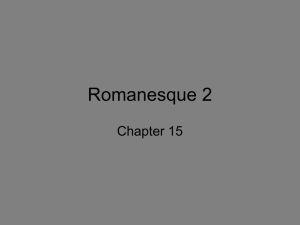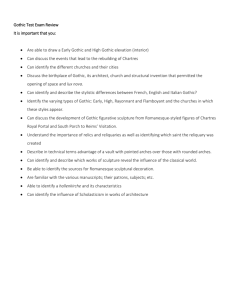Gothic Art
advertisement
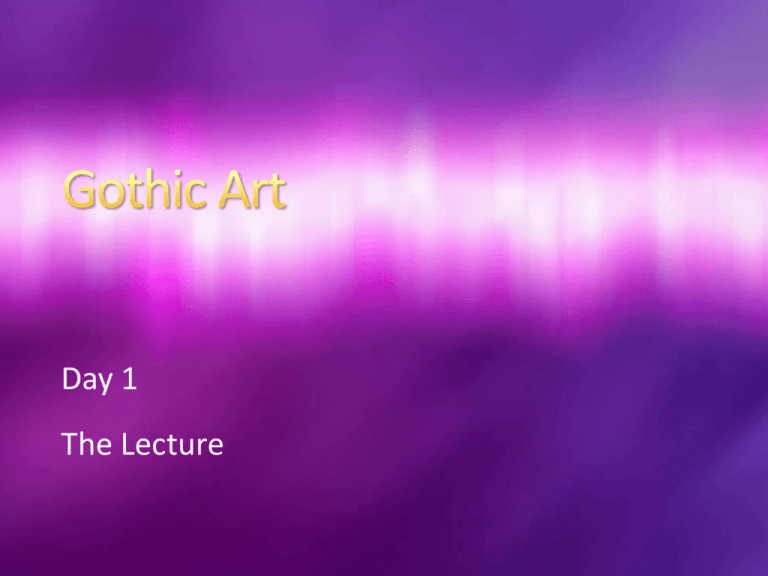
Day 1 The Lecture The power and influence of the church had reached extreme heights and so to reflect that power and devotion the churches were designed and build the reflect the greatness of God and stood as symbols of the local communities devotion L HE I GHT G H T Communities strove for higher and higher buildings, and to solve the issues of light made many innovations in building in order to flood interiors with “Heavenly” light. What does it mean? The term “Gothic” was used by Giorgio Vasari, (the father of art history) in 1550 He lived at the height of the Renaissance He used it to describe late medieval art/architecture It was meant to be derisive He thought that Gothic art was monstrous and barbarous, invented by the Goths- the barbarians When did it happen? 1140-1500 The dates are not exact and this style was the not rule everywhere It mostly existed in France, England, Germany and Northern Italy War The Black Plague The Hundred Year War 1337 to 1453 between the Kingdom of England and the Kingdom of France and their various allies The Great Schism a split within the Catholic Church from 1378 to 1417. Two men simultaneously claimed to be the true pope. Driven by politics rather than any theological disagreement, the schism was ended by the Council of Constance (1414–1418). The simultaneous claims to the papal chair of two different men hurt the reputation of the office. one of the most devastating pandemics in human history, peaking in Europe between 1348 and 1350. ¼- 1/3 of the population of Europe died as a result The centers of religious/intellectual life shifted from the monasteries to the cities. Catholic Church was at the height of its power Modern nations begin to take shape – Rib vaults – pointed arches – Flying buttresses – Rectangular bay system – Extreme height – Interior flooded with light • Stained glass – Rose window – Space and soaring verticality – Sculptural • Decoration/building punctured on the outside to achieve open space Flying buttress Rib Vault Clerestory Triforium Aisle Nave Early= round columns in the interior. Rib vaults start at the ceiling but travel down only to the top of the column capitals. Note dame and Saint –Denis are Early Gothic High=articulated columns in the interior. Rib vaults travel from the ceiling and down to the floor; larger windows and choirs; compound piers are common; more sculpture on the façade. Amiens and the interior of Charters are High Gothic. Rayonnant= (meaning radiating) a dissolution of the wall space with great sheets of glass like rose windows; thin groups of column shafts; refined tracery is used throughout. SaintChapelle is Rayonnant Gothic. Late/Flamboyant= (meaning flaming) is highly decorative. A mass of panicles and tracery. The decoration acts as a seethrough screen in which the forms are reveled. Ogee (very pointed) arches are used. Saint-Maclou is a flamboyant Gothic. First gothic building -Abbot Suger, the patron, wanted light filtered by stained glass to saturate the inside of the building -Rib vaults start at the ceiling and travel down to the capitals, the columns are round and unarticulated -Pointed arches -Moves away form the demarcation of spaces in the Romanesque period and embraces a more organic feel, which creates a continuous space as the spaces flow into each other. -minimizes mass and weight on the interior Suger believed that art is made for the honor of God and the saints In addition, Suger felt that there is a reciprocal relationship between the celestial and the terrestrial in art. Essentially, the theory is based on the idea of returning to God a part of what God has already given (thus, through the use of precious materials, stone, etc; the materials themselves possess sacred virtues). Suger supported the idea that a material representation had the ability to raise one's senses to a vision of the eternal ideal, "urging us onward from the material to the immaterial" • the spiritual nature of light. • The lightening of the structure allowed for larger stained glass windows to flood the interior with mystical light. • New architectural innovations – – – – – Flying buttress Pointed arch Stain Glass Rib vaults Rectangular bays -Flying buttresses first used on a large scale here -early gothic building; rib vaults start at the ceiling and go down as far as the capitals on the columns -Sexparte or six part vaults -Vaults span two bays -Façade First floor portal sculpture Second floor a “kings” gallery with 28 kings form the Old Testament Third floor rose window 30 feet across Fourth floor hanging space for bells (and hunchbacks ) Fifth floor bell towers Sexpartite vault Retained some Romanesque features Combined them with the Gothic Rib vault on pointed arches Triforium- 4 story interior elevation Huge rose window Deep porches in front of doorways Open towers • Round columns • Rib vaults travel from vault to capitals • Beginning to add heavy decoration to exterior • Gallery above aisles (in some still) Notre Dame Laon -Begun as a Romanesque cathedral it burned down and was rebuilt in part as Gothic -High Gothic nave -Each vault spans only one bay -Large windows -Legendary stained glass -Façade; south tower (right) from 1160 and the north tower (left) is form 1507-1513 -Four part rib vaults -Vaults very high 148 feet -larger expanse of windows -Façade; more extravagant use of sculpture muscular concentration of dark and light architectural projection -Sculpture above the doors and in the arches -narrowing of the nave enhances verticality -Merchant creates Gothic house -Banker, Merchant, and finical advisor to French King and a Pope -Broad façade with a tightly pitched roof -Pointed arches stained glass -False windows hold life sized servants who look down onto the street -Triumph of the city and merchants Rib vaults travel from vaults to floor Larger choirs More sculpture 3 part nave elevation Sculpture is more complex and decorative High Gothic Formula Rectangular bay system Four part rib vault Buttressing system Amiens Chartres -dissolution of the walls ¾ of wall is glass -slender columns -sheets of glass -built to house king Louis IX relics including the crown of thorns -symbolizes a giant reliquary -Adjoins the royal palace Lots of Tracery In architecture, Tracery is the stonework elements that support the glass in a Gothic window • May also be called Court style due to its association with Paris and the royal court of Louis IX (This continues into the High Gothic) • The style dominated the second half of the century • Gets name from its radiating bar tracery • Dissolve walls w/stained glass • Less stone work- almost none • Tracery throughout -Mostly French -It is small as the French were running out of money and Gothic was becoming less popular -The ribbing and “tracery” create places where light unencumbered by glass fly’s through the exterior of the building -Overlapping organic stonework create a bewildering complex view • “Flame like” tracery • Extreme decoration – pointed tracery – Ogee arch Smaller in size- Gothic was becoming less popular and they were running out of $ • In sculpture there is a body under the drapery, secular persons are depicted • Suffering is shown – Black Death -English Gothic style -Not so high -Double transept -Emphasis on the soaring tower -Long nave, short transept -Fan vaults -Organic -English desire for knotting references the Celtic knotting form the early medieval period -Linked to the Flamboyant style in France -Perpendicular gothic (unique to England) • Decorated Style • Perpendicular Style • Fan Vaulting • horizontal emphasis in a long rectilinear plan • more emphasis on the cross tower than the façade • less interest in height • Nave ends with a flat wall rather than in a round apse

